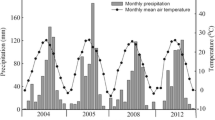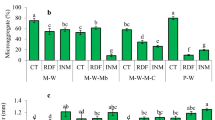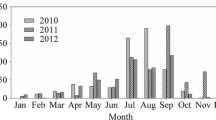Abstract
To evaluate the response of dryland wheat (Triticum aestivum L.) to mulching in preceding maize and fertilizer N application field experiments were conducted for six years (1980–86) with maize-wheat sequence on a sandy loam soil in northern India. Four rates of N application viz. 0, 40, 60 and 80 kg N ha−1 in wheat were combined with three mulch treatments viz. no mulch (M0), paddy straw mulch (Mp) and basooti (Premma mucronate) mulch (Mb) applied at the rate of 4 tons ha−1 on dry weight basis applied three weeks before harvest of maize. Mulching (Mp and Mb) increased (profile) stored moisture at wheat seedling by 31 to 88 mm. Mb also increased NO3-N content by 33 to 42 kg ha−1 in 0–120 cm profile over M0 and Mp. Over the years, Mp increased wheat yield by 11 to 515 kg ha−1 and Mb by 761 to 879 kg ha−1. Wheat yield response to mulching was related to rainfall pattern during its growth season. Significant response to mulching was obtained only in years when rainfall during vegetative phase of the crop was low. Amount and distribution of rainfall during two main phases of crop development affected the N use efficiency by wheat. On an average, each cm of rain substituted for 3.5, 4.6 and 6.5 kg of applied N ha−1 under M0, Mp and Mb, respectively. Split rainfall for two main phases of crop growth, available stored water at seeding, fertilizer N and profile NO3-N content accounted for 89 per cent variability in wheat yield across years and mulching treatments.
Similar content being viewed by others
References
Army TJ, Wiese AF and Hanks RJ (1961) Effect of tillage and chemical weed control practices on soil moisture losses during the fallow period. Soil Sci Soc Am Proc 25: 410–413
Benbi DK (1990) Efficiency of nitrogen use by dryland wheat in a subhumid region in relation to optimising the amount of available water. J Agric Sci (Camb) 115: 7–10
Black AL (1973) Soil property changes associated with crop residue management in a wheat-fallow rotation. Soil Sci Soc Am Proc 37: 943–946
Black F and Siddoway FH (1979) Influence of tillage and wheat straw residue management on soil properties in the Great Plants. J Soil Water Conserv 34: 220–223
Bremner JM (1965) Inorganic forms of nitrogen. pp 1179–1237 In: Black CA (ed.) Methods of soil analysis 2, Agronomy 9, Am Soc Agron, Madison, Wis
Fryrear DW and Koshi PT (1971) Conservation of sandy soils with a surface mulch. Trans ASAE 14: 492–495
Greb BW, Smika DE and Black AL (1970) Water conservation with stubble mulch fallow. J Soil Water Conserv 25: 58–62
Jackson TL, Halvorson AD and Tucker BB (1983) Soil fertility in dryland agriculture. pp 297–332 In: Dryland agriculture. Agron N. 23, Am Soc Agron, Madison, Wis
Johnson WC and Davis RG (1972) Research on stubblemulch farming of winter wheat. USDA Conserv Res Report No 16
Kumar D and Singh R (1985) Effect of farmyard manure on nitrogen use efficiency in maize-wheat sequence under rainfed conditions. Bull Indian Soc Soil Sci 13: 318–325
Olsen SR, Cole CV, Watanabe FS and Dean LA (1954) Estimation of available P extraction with sodium bicarbonate. USDA Circ No. 939, USDA, Washington.
Olson RA (1984) Nitrogen use in dryland farming under semi arid conditions. pp 335–347 In: Hauck RD (ed.) Nitrogen in crop production. Am Soc Agron, Madison, Wis
Olson RA, Dreier AF, Thompson C, Frank K and Grabouski PH (1964) Using fertilizer nitrogen effectively on grain crop. Nebraska Agric Exp Stn Bull No 479
Passioura JB (1983) Roots and drought resistance. Agric Water Manage 7: 265–80
Power JF (1978) Crop residues-not a waster. Agric Res 27(2): 11
Prihar SS and Hundal SS (1971) Determination of bulk density of soil clod by saturation. Geoderma 5, 283–286
Prihar SS, Sandhu KS, Singh Y and Singh R (1981) Effect of N rates on dryland wheat in relation to mulching previous crop or fallow. Fert Res 2: 211–219
Prihar SS, Sandhu KS, Singh M, Verma HN and Singh R (1989) Response of dryland wheat to small supplemental irrigation and fertilizer nitrogen in submontane Punjab. Fert Res 21: 23–28
Ramig RE and Rhoades HF (1963) Interrelationships of soil moisture level at planting time and nitrogen fertilization on winter wheat production. Agron J 55: 123–127
Unger PW (1978) Straw mulch rate effect on soil water storage and sorghum yield. Soi Sci Soc Am J 42: 486–491
Walkley A and Black CA (1934) An examination of the degtjareff method for determining soil organic matter and a proposed modification of the chromic acid titration method. Soil Sci 37: 29–38
Young RA, Ozbun JL, Bauer A and Vasey EH (1967) Yield response of spring wheat and barley to nitrogen fertilizer in relation to soil and climatic factors. Soil Sci Soc Am Proc 31: 407–410
Author information
Authors and Affiliations
Rights and permissions
About this article
Cite this article
Sandhu, K.S., Benbi, D.K., Prihar, S.S. et al. Dryland wheat yield dependence on rainfall, applied N and mulching in preceding maize. Fertilizer Research 32, 229–237 (1992). https://doi.org/10.1007/BF01048785
Received:
Accepted:
Issue Date:
DOI: https://doi.org/10.1007/BF01048785




